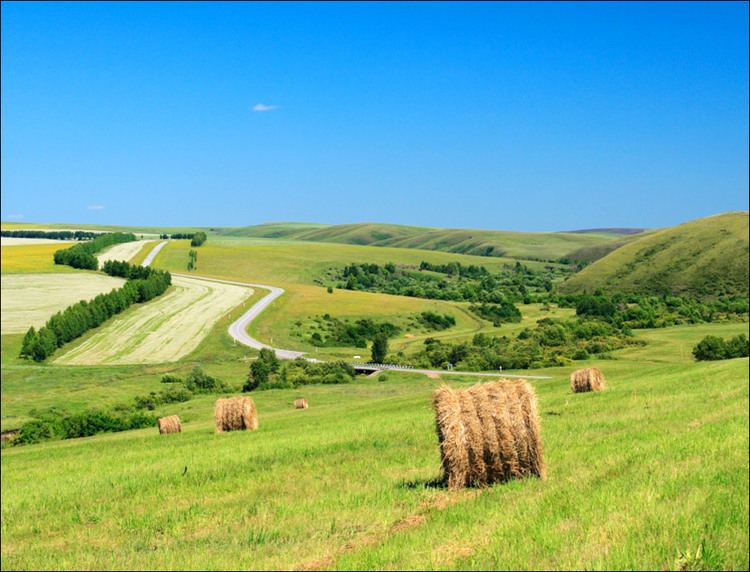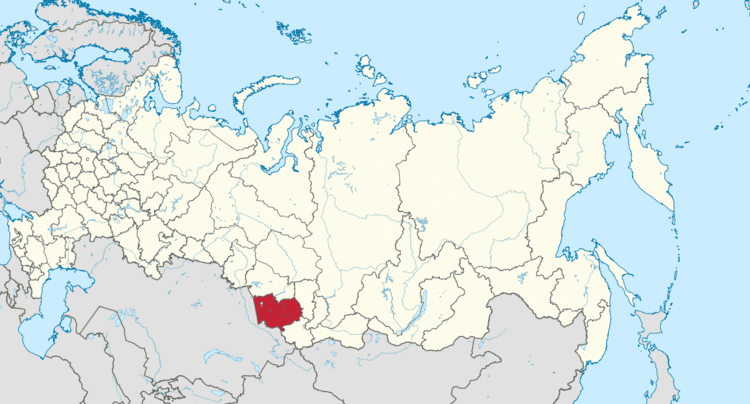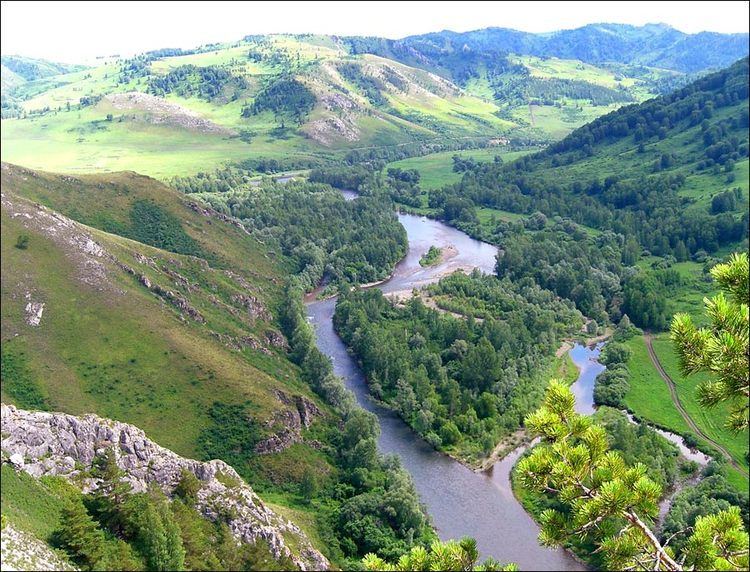Country Area 169,100 km2 Governor | Language spoken Official website Founded September 28, 1937 | |
 | ||
Destinations Colleges and Universities Altai State University (Barnaul), Altai State Technical University (Barnaul), Altai State Medical University (Barnaul), Altai State Pedagogical University (Barnaul), Altai State Academy of Education (Biysk) | ||
Map of Altai Krai
Altai Krai (Russian: Алта́йский край, Altaysky kray; [ɐlˈtajskʲɪj kraj]) is a federal subject of Russia (a krai). It borders with, clockwise from the west, Kazakhstan, Novosibirsk and Kemerovo Oblasts, and the Altai Republic. The krai's administrative center is the city of Barnaul. As of the 2010 Census, the population of the krai was 2,419,755.
Contents
- Map of Altai Krai
- Altan katun river altai krai russia
- Geography
- History
- Flag
- Coat of arms
- Politics
- List of Chairmen of the Altai Krai Legislative Assembly
- Demographics
- Religion
- Sister district
- References

Altan katun river altai krai russia
Geography

Altai Krai has rolling foothills, grasslands, lakes, rivers, and mountains.

The climate is severe with long cold dry winters and hot, usually dry summers. The region's main waterway is the Ob River. The Biya and Katun Rivers are also important. The biggest lakes are Lake Kulundinskoye, Lake Kuchukskoye, and Lake Mikhaylovskoye.

Altai Krai has huge reserves of raw materials, especially materials used for building, as well as significant mineral reserves. These include nonferrous metals, lead and iron ores, manganese, tungsten, molybdenum, bauxite, and gold. Forests cover about 60,000 km² of the krai's land. See also Geography of South-Central Siberia.
This region of Siberia is extremely important due to its biodiversity, an area of over 1.6 million hectares is recognised by Unesco as a world heritage site and even the endangered snow leopard has made his home there.
The Altai bees (Apis mellifera) are hardy and healthy they are renowned for producing some of the world's finest organic honeys. Historically honey was used by the peoples of Altai and Bashkiria as payment or yasak (levy or tax) to the Russian Tsars.
History
This area is part of a great crossroads in the ancient world. Nomadic tribes crossed through the territory during periods of migration. The nomadic tribes were composed of different peoples. Archeological sites reveal that ancient humans lived in the area. The Altay people are a Turkic people, some of whom have settled here, who were originally nomadic and date back to the 2nd millennium BCE.
The territory of the krai has been controlled by the Xiongnu Empire (209 BC-93 CE) and Mongolian Xianbei state (93-234), Rouran Khaganate (330-555), Mongol Empire (1206-1368), Golden Horde, Northern Yuan (1368-1691) and Zunghar Khanate (1634–1758).
In June 1942 Altai Krai was one of the places to which women and children and the wives of men deported from Eastern Europe, in particular "Foreigners" and "Other ethnicities" such as Kola Norwegians, Lithuanians and Latvians, by Soviet Russia to hard labor camps.
Flag
The flag of Altai Krai is red and blue with a yellow stripe on it as a symbol of agriculture. In the center of the flag is the coat of arms of Altai Krai.
Coat of arms
The coat of arms of Altai Krai was established in 2000. It includes a shield of French heraldry form with a basement of 8/10th of its height and a sharp part in the middle of the bottom part. Bottom edges of the shield are rounded. The shield is divided with a horizontal stripe into two equal parts. In the upper part has a blue background, which is a symbol of glory, is a steamy oven of the 18th century, which reflects a historical past of the krai. In the bottom part on the red background, which is a symbol of dignity, braveness and courage, is an image of the Koluvan Queen of Vases mainly in green color, which is kept in the Hermitage Museum. The shield is framed with golden wheat ears which represent agriculture as a main industry of Altai Krai.
Politics
During the Soviet period, the high authority in the krai was shared between three persons: The first secretary of the Altai CPSU Committee (who in reality had the most authority), the chairman of the Krai Soviet (legislative power), and the Chairman of the Krai Executive Committee (executive power). Since 1991, CPSU lost all the power, and the head of the krai administration, and eventually the governor was appointed/elected alongside elected regional parliament.
The Charter of Altai Krai is the fundamental law of the region. The Legislative Assembly of Altai Krai is the regional standing legislative (representative) body. The Legislative Assembly exercises its authority by passing laws, resolutions, and other legal acts and by supervising the implementation and observance of the laws and other legal acts passed by it. The highest executive body is the Krai Government, which includes territorial executive bodies such as district administrations, committees, and commissions that facilitate development and run the day to day matters of the province. The Krai Administration supports the activities of the Governor who is the highest official and acts as guarantor of the observance of the krai Charter in accordance with the Constitution of Russia.
On August 7, 2005 the krai's then-head of administration Mikhail Yevdokimov died in a car crash.
List of Chairmen of the Altai Krai Legislative Assembly
The Chairman of the Altai Krai Legislative Assembly is the presiding officer of that legislature.
Demographics
Population: 2,390,638 (2014 est.); 2,419,755 (2010 Census); 2,607,426 (2002 Census); 2,822,305 (1989 Census).
As of the 2010 Census, Russians form an overwhelming majority of the population, at 94%. Germans are the second-largest group, at about 2% (see Mennonite settlements of Altai). Other groups include Ukrainians (1.4%), Kazakhs (0.3%), Tatars (0.3%), Belarusians (0.2%), Armenians (0.3%), and people of other ethnicities. Additionally, 40,984 people were registered from administrative databases, and could not declare an ethnicity. It is estimated that the proportion of ethnicities in this group is the same as that of the declared group.
2009 - 1.62 | 2010 - 1.63 | 2011 - 1.65 | 2012 - 1.81 | 2013 - 1.83 | 2014 - 1.84 | 2015 - 1.81 | 2016 - 1.79(e)
Religion
According to a 2012 survey 22.6% of the population of Altay Krai adheres to the Russian Orthodox Church, 3% are unaffiliated generic Christians, 1% are Orthodox Christian believers without belonging to any church or are adherents of other Orthodox churches, 1% are adherents of Islam. In addition, 31% of the population declares to be "spiritual but not religious", 27% is atheist, and 14.4% follows other religions or did not give an answer to the question.
